Affiliate disclosure: This post may contain affiliate links. Please see our Privacy Policy.
Dandelion seeds are edible! Every part of the dandelion plant is edible, and the seeds are no exception. Believe it or not, it’s easy to harvest the seeds and separate them from the fluff, and they can be used in so many creative ways.
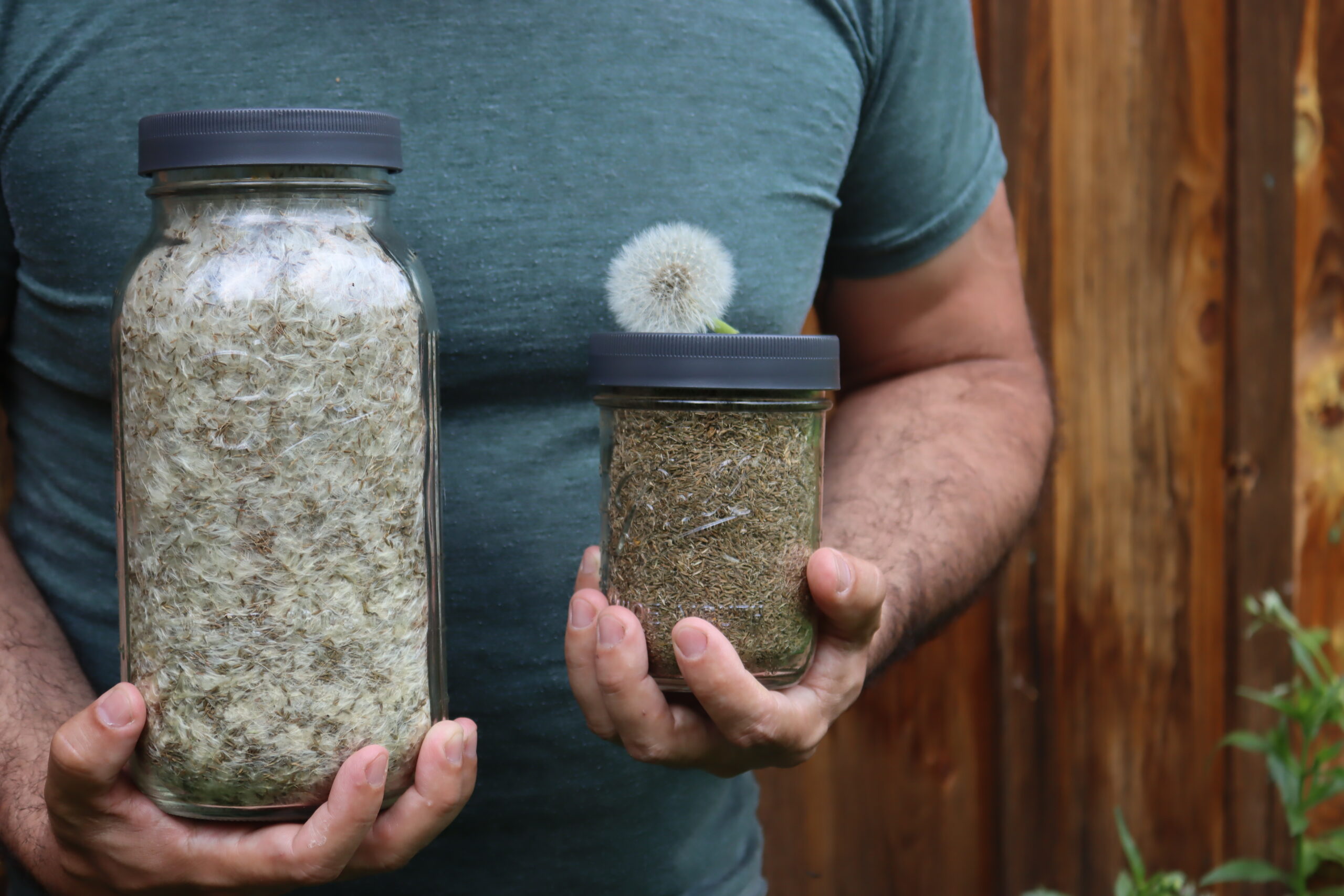
Table of Contents
- How to Clean Dandelion Seeds
- Dandelion Seed Recipes
- Toasted Dandelion Seeds
- Dandelion Sprouts
- Dandelion Microgreens
- Dandelion Seed “Milk”
- Dandelion Seed Muffins
- Dandelion Seed Bars
- Dandelion Seed Crackers
- Dandelion Seed Mustard
- Dandelion Seed Flour
- Dandelion Seed Granola
- Dandelion Seed “Oatmeal”
- Dandelion Seed Cheese
- Dandelion Seed Oil
- Other Dandelion Seed Recipes
- Identifying Dandelion Seeds
- Dandelion Recipes
Every part of the dandelion plant is edible, and some of the first settlers to immigrate from Europe to the US brought dandelion seeds with them (on purpose) to plant. Easy to grow and prolific, this early spring green was once an important nutrient source for rich and poor alike.
We love eating dandelions, and every year, I try to find a few new dandelion recipes to add to our collection.
On our 30 acres, I like to joke that we’re basically dandelion farmers, and we could harvest these plants by the tractor-trailer load, and you’d never notice. They’re that prolific, and there’s a darn good reason they’re considered invasive.
My kids are absolute fiends for dandelion recipes, and every year, they skip out into our fields to fill their baskets with bright, sunny blossoms for our favorite dandelion flower recipes. The blossoms are easy to love, as the petals taste like honey and work well in all manner of dandelion dessert recipes.
Getting the littles interested in the other parts took a bit of creativity, but they loved dandelion root cake (like carrot cake, but with dandelion roots). Dandelion root “coffee” was a big hit too, along with other dandelion root recipes.
The greens are, well…more green, and they’re definitely a vegetable. Still, they’re great sauteed with a bit of bacon or made into an epic dandelion green pesto.
So we’ve covered flowers, roots, greens…but what about dandelion seeds?
Dandelion seeds are, in fact, edible, and they’re easily collected en masse. So long as you know the trick to quickly separating the seeds from the fluff, you can harvest a pint of seeds in no time.
I’m going to walk you through recipes for using dandelion seeds for all manner of tasty edibles, but first, I’ll show you a few different methods to separate the seeds from the fluff (in seconds).
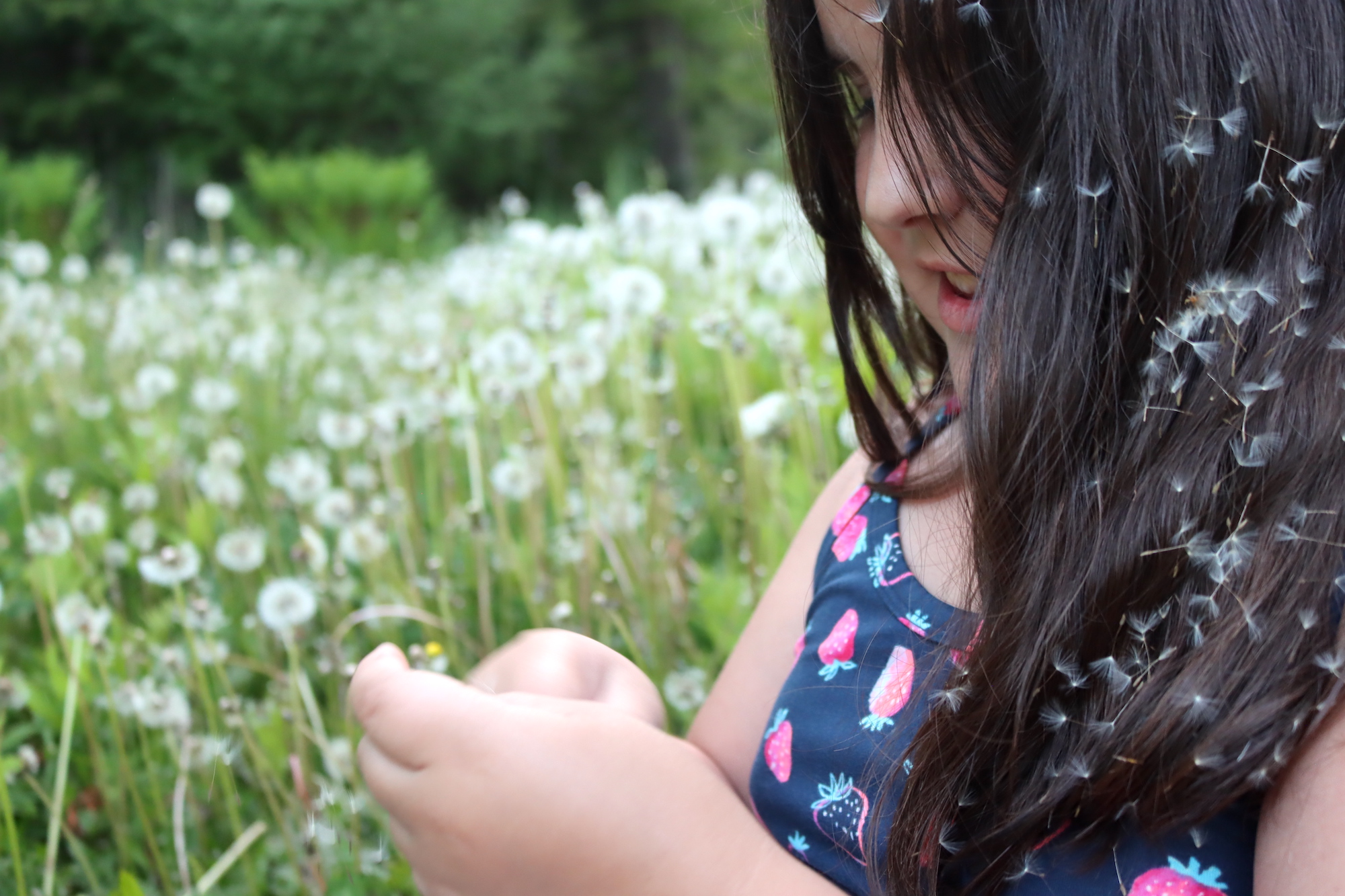
How to Clean Dandelion Seeds
There are several easy methods for cleaning dandelion seeds.
The first (and simplest) is to gather the seeds into a paper or plastic bag. Once the bag is full, simply work it with your hands, and the seeds will detach from the fluff easily. This idea actually came from Pascal Baudar, who collects hundreds of species of edible wild seeds and grain.
Put the bag between your flat palms, and imagine you’re making a play dough snake. Just slip them back and forth against each other, with the bag in between.
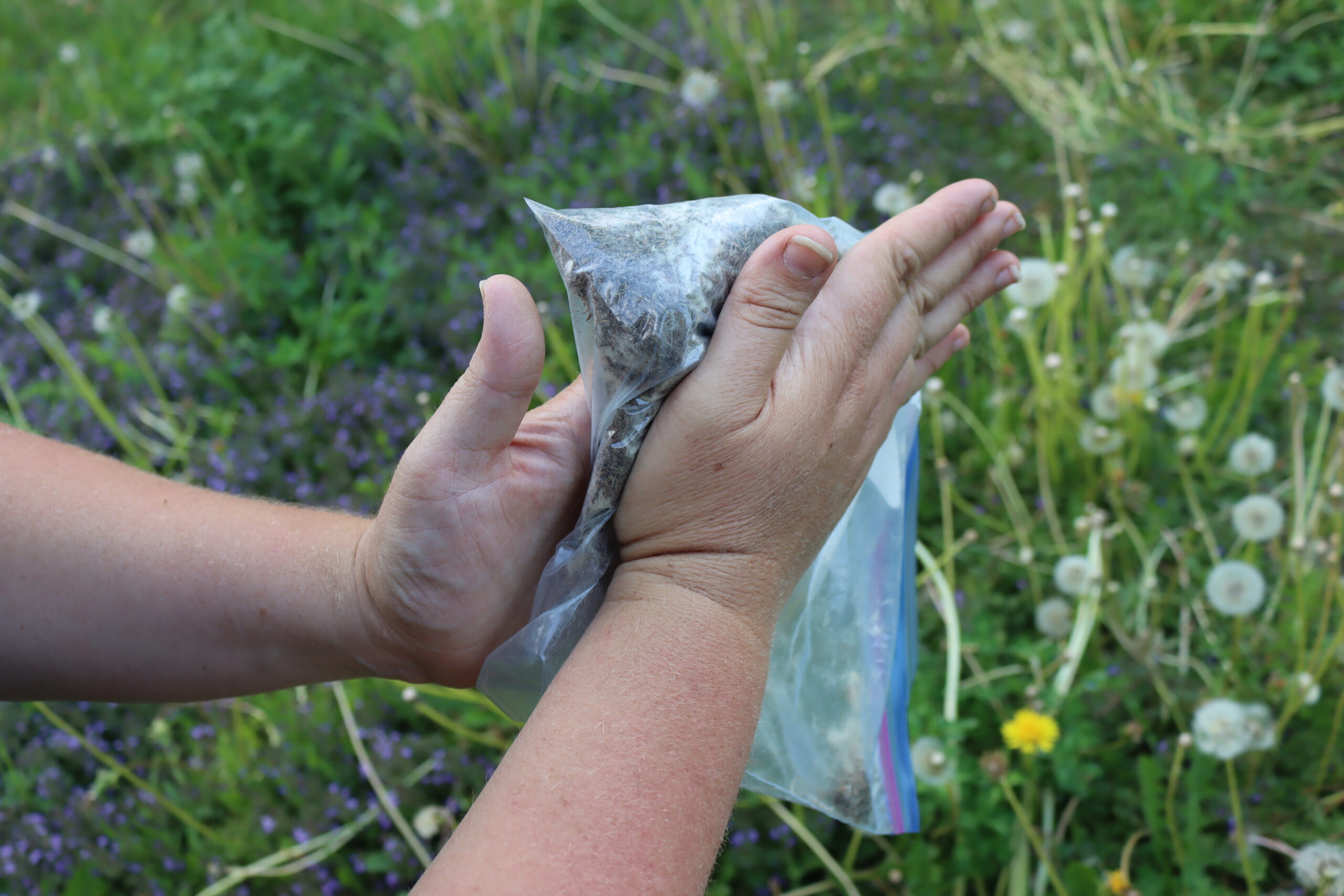
In about 30 seconds, the seeds have fallen to the bottom of the bag, and the fluff is matted at the top.
This process is incredibly quick and efficient, and honestly, it’s by far the best method. You don’t have to use a plastic bag, as a paper bag works just as well.
In a pinch, you could also use an old pillow case or even an old t-shirt if you tie the neck and sleeves closed. Really, anything that you can contain the seeds inside so they stay in one place during a quick rub.
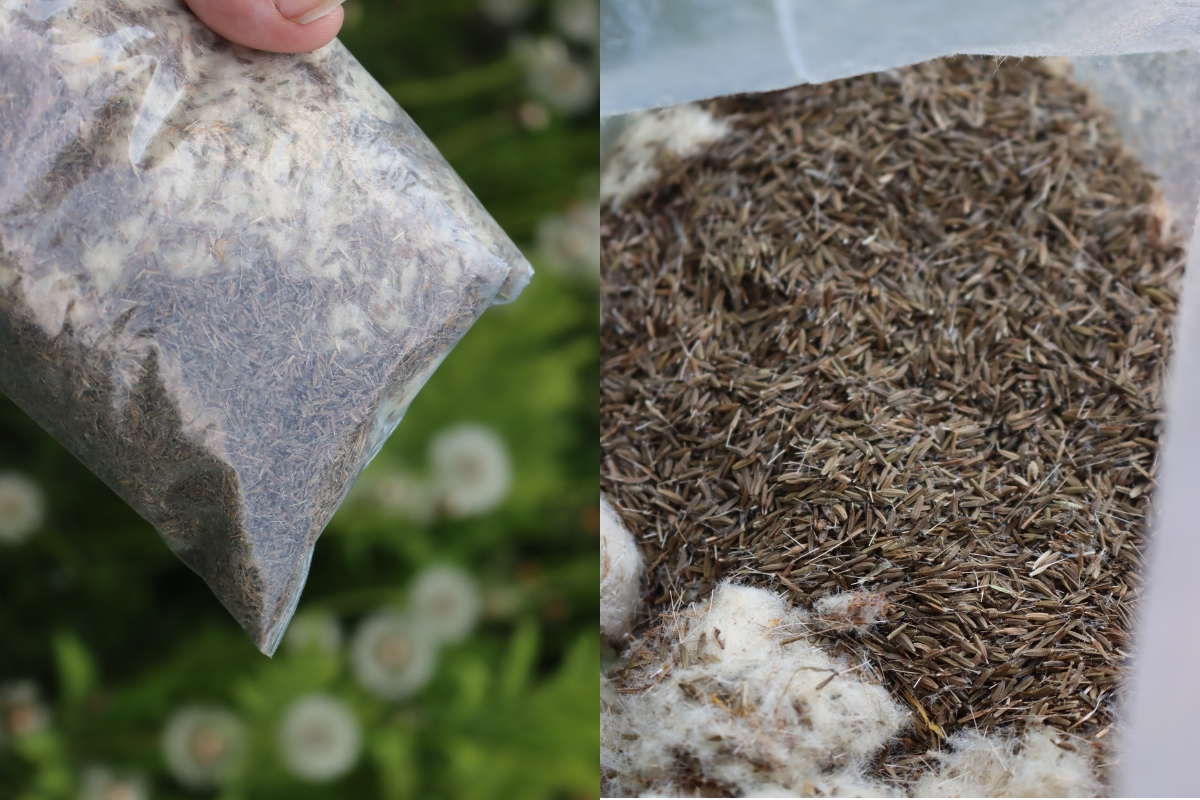
It took me about half an hour to collect a gallon ziploc bag of dandelion seeds. Left fully, they fill a gallon ziploc, but the same amount packed will also fill a half-gallon mason jar. However you want to measure it, a gallon fluffy, or half gallon packed, doesn’t matter. The seed yield in the end is the same.
After 30 seconds of separation, I had a mass of tangled fluff and about a pint of cleaned seeds.
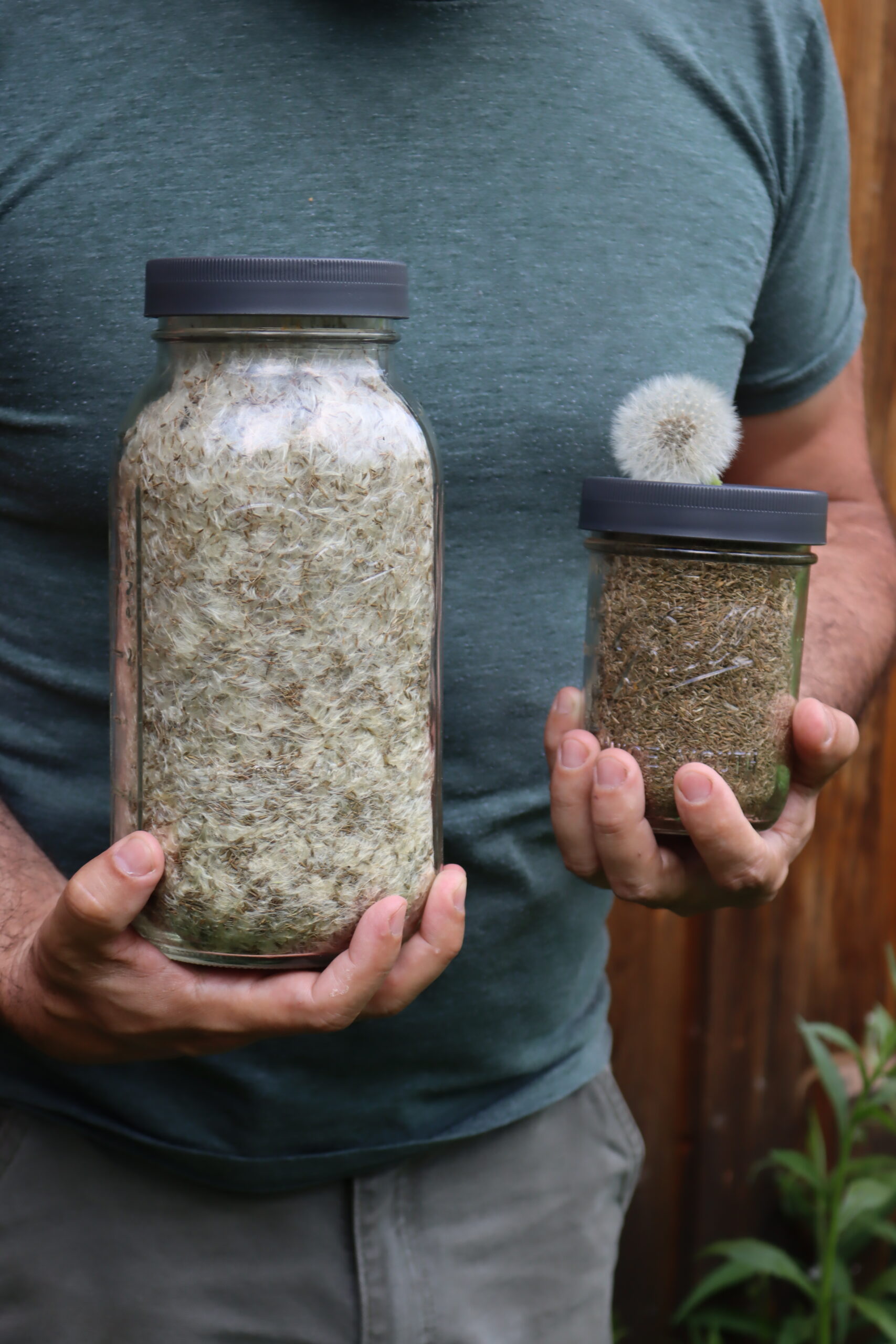
The dandelion fluff still has a few seeds in it, but 80% of them are separated in seconds. Toss the rest of the fluff somewhere you’d like to encourage dandelions the following year, and you’ve given a bit back.
You can also pass the mixture through a fine mesh sieve to collect a bit more. The fluff is matted together, and won’t pass through the sieve.
The loose seeds will shake right through into the bottom for collection.
Of course, some are still stuck in the matted fluff, and those can now go back to nature.
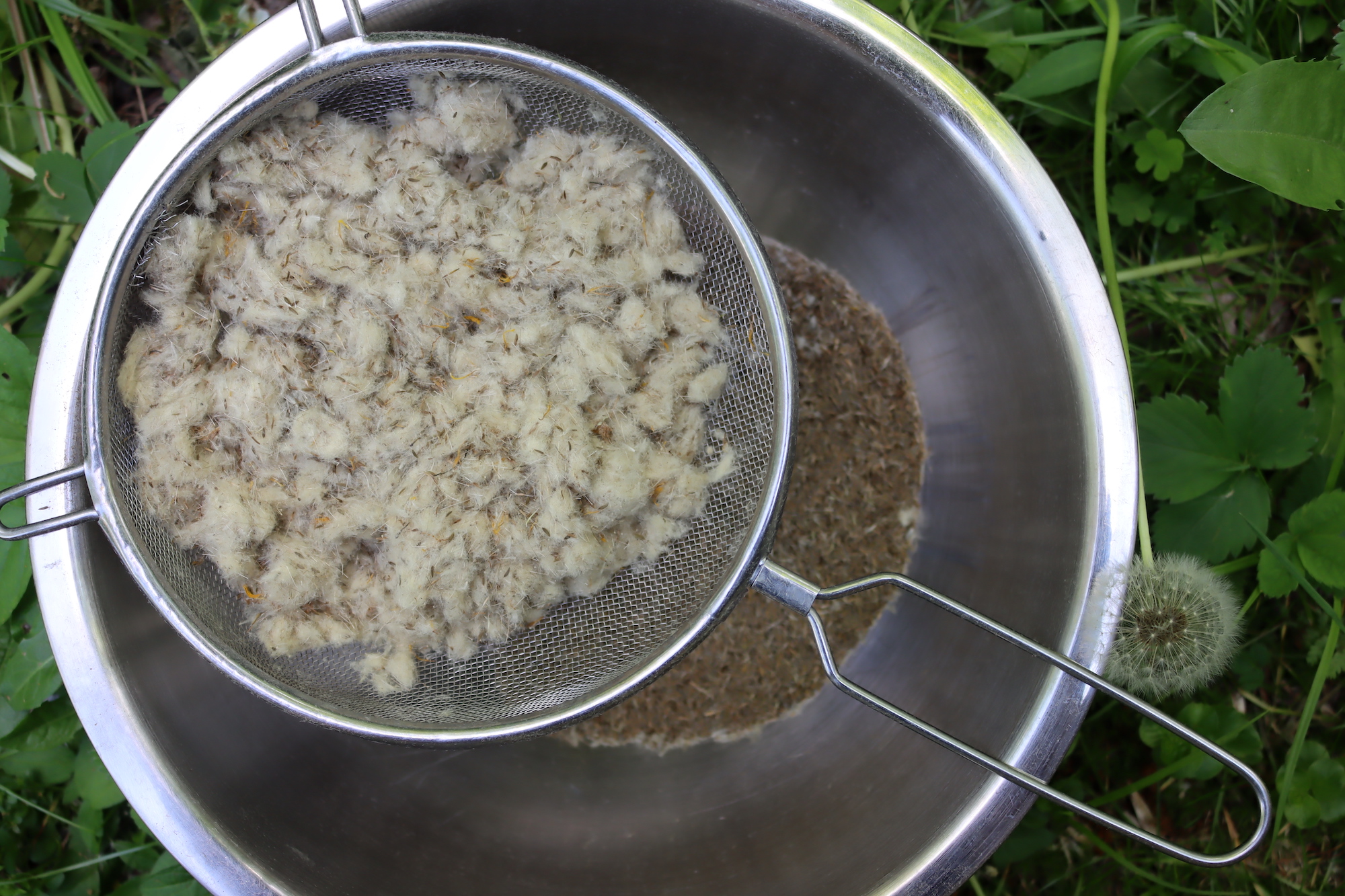
When I looked at the fluff, it seemed like it’d make an excellent pillow stuffing, and it’s awfully similar to the milkweed fluff they used in WWII to fill life jackets. It also looks like an excellent tinder source…and when I tested it, it ignited instantly.
I made a quick dandelion fiber lamp by placing a bit at the bottom of a mason jar and adding a bit of oil. The flammable dandelion fiber acted as a long-lasting wick, and the oil burned, providing heat and light for an extended period.
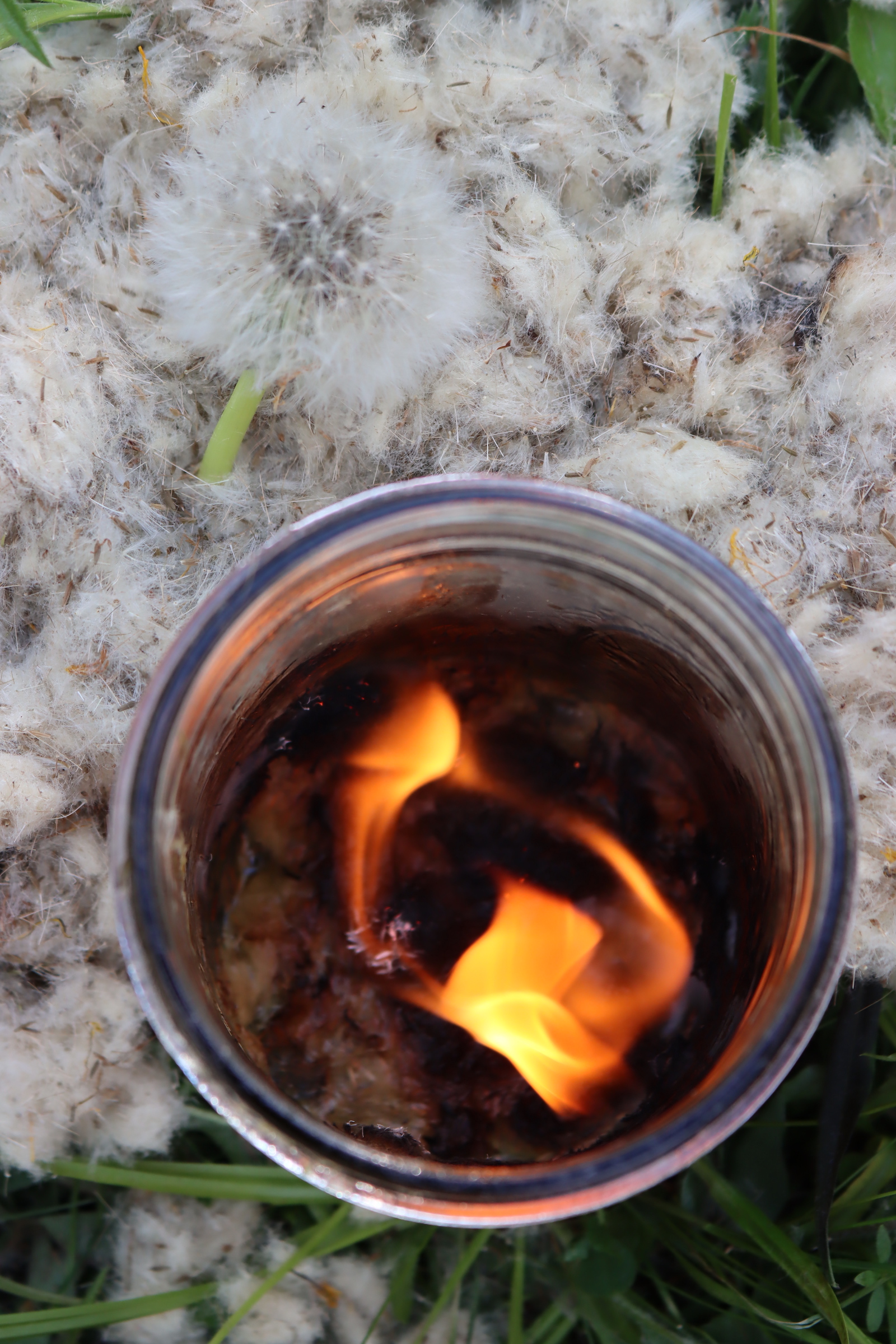
That got me wondering if I could clean dandelion seeds with fire….because solving problems with fire is always more fun than hand scrubbing.
(Even if hand scrubbing is fast and efficient.)
I held a lighter to a dandelion blossom, and it went up as a poof of flame instantly.
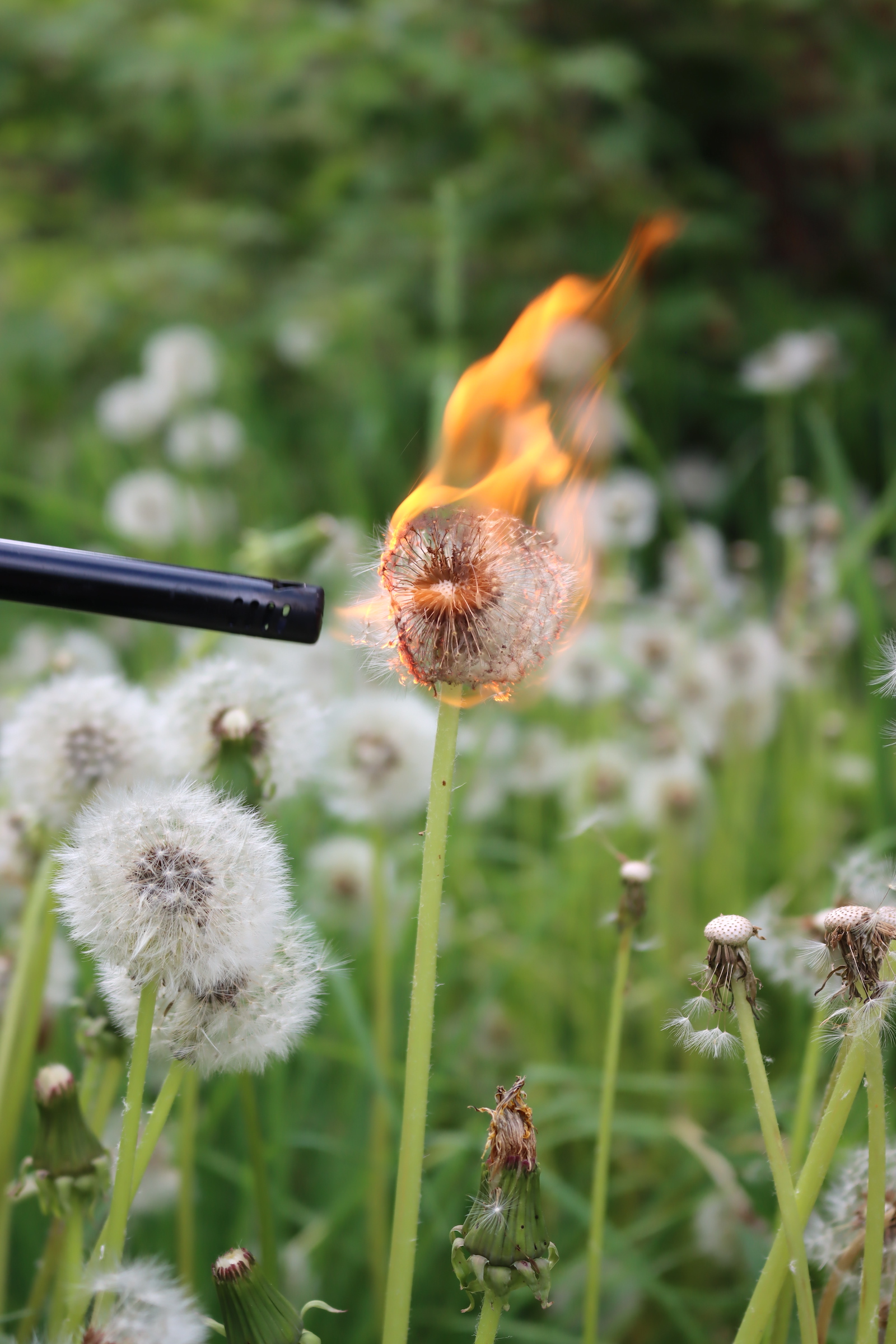
My husband was suddenly excited and declared, “See, sweety? That’s why I need a flamethrower for my birthday! It’s to help you with foraging!”
So, lighting a field of dandelion seed heads on fire isn’t all that practical, even if you do secretly want a flame thrower for recreational purposes. Lighting them after harvest (rather than on the plant) is much easier (and obviously easier on the plant).
Joking aside, on a larger scale, if you harvest the seeds into a metal bowl and then touch a lighter to the fluff, it will burn away in seconds.
A quick stir will ensure it all burns, and then you have just the cleaned seeds.
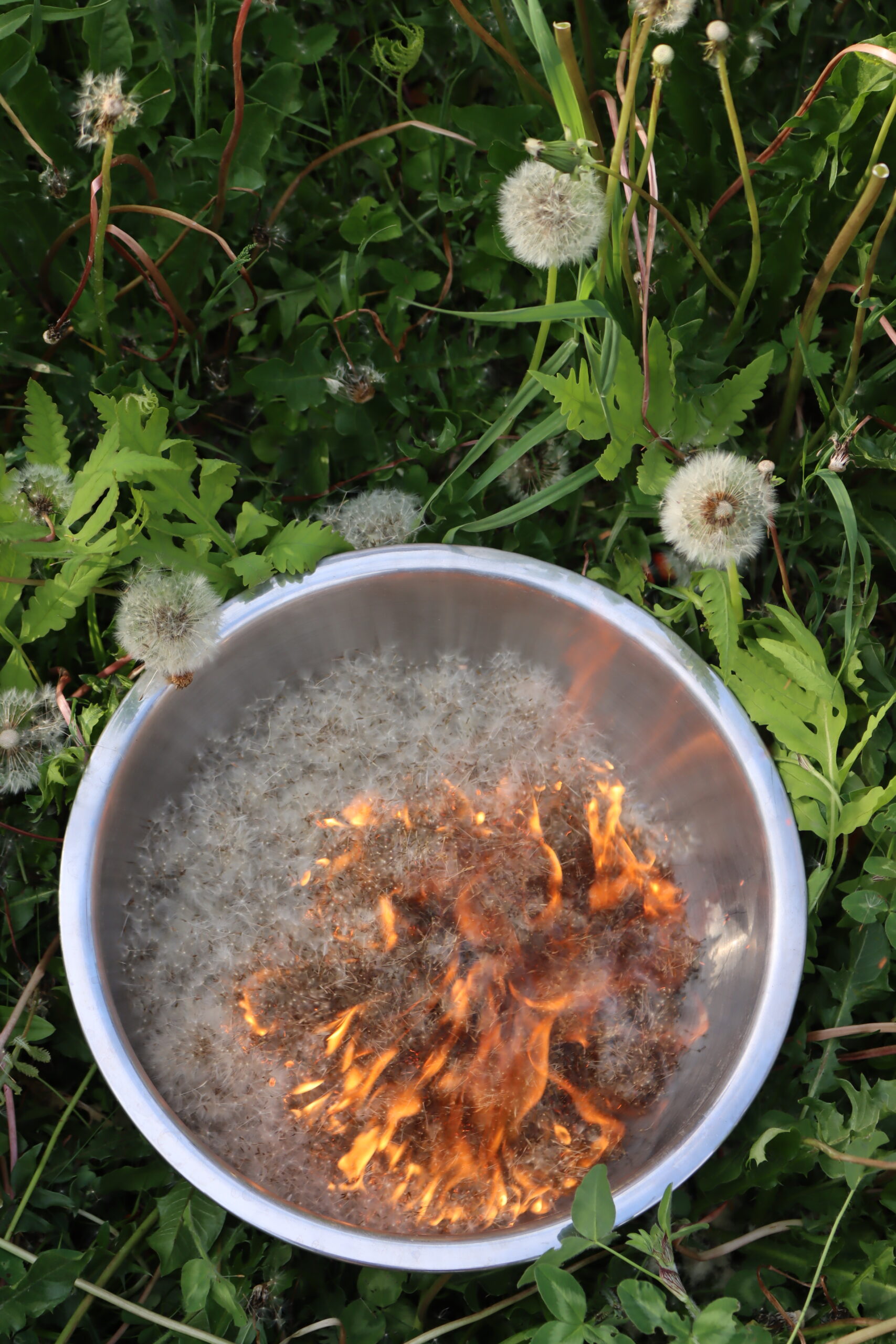
If you’re only doing a very small amount of dandelion seeds, for a tablespoon or two of microgreens or sprouts, you can harvest them carefully and clean them by hand.
Just pinch them between your fingers and pull out the fluff.
This is the least efficient method, but it does work just fine in small quantities. I’d suggest using the bag method if you want to harvest more than 1/4 cup of seeds.

So, while you’d assume that cleaning dandelion seeds would be difficult and time-consuming, both the bag method and the fire method leave you with plenty of cleaned seeds in seconds.
It takes a bit to gather them, but as I mentioned, you can gather a gallon of fluff (unpacked) or a half gallon of fluff (packed) in about half an hour. That yields about a pint of cleaned seeds.
Of course, if you stop to make wishes, as you well should, it takes a bit longer.
Even if you’re not intentionally spreading the seeds, gathering dandelion seeds without kicking them about is impossible. Each plant produces about 15,000 seeds…and you’ll let loose at least a thousand by accident in the process.
Even if you eat the rest, that plant’s progeny are doing fine.
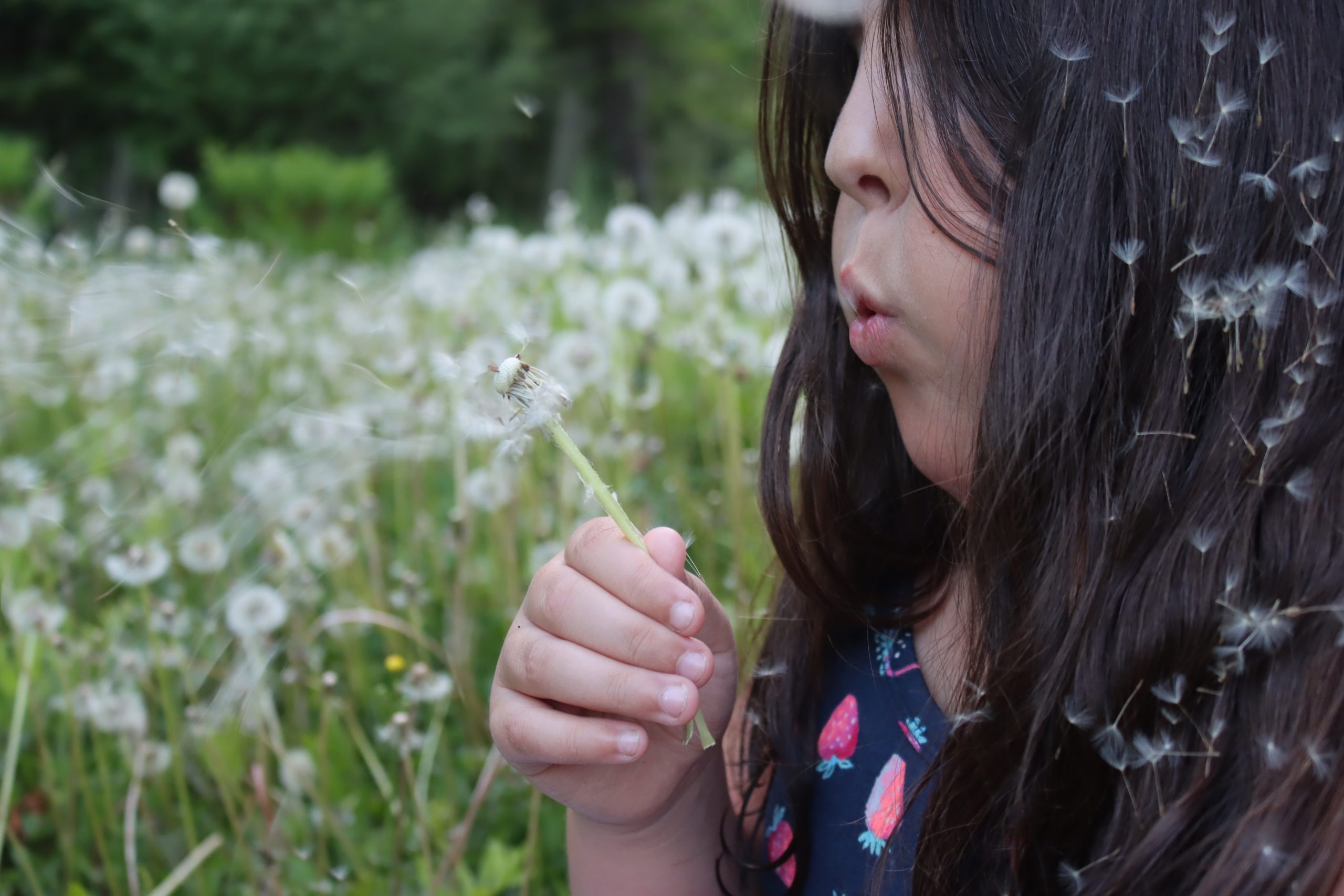
Dandelion Seed Recipes
Now that you have cleaned dandelion seeds, how do you use them?
There are dozens of delicious ways to use dandelion seeds. They can be sprouted as microgreens (or sprouts), made into seedy muffins (in place of poppy seeds), added to granola, or made into dandelion seed milk (like almond milk, but locally harvested).
I’ve tested out a dozen or so recipes based on my ideas (below). If you have other ideas, I’d love to hear about them. Leave me a note in the comments, and I’ll see about trying it out in the coming year.
Toasted Dandelion Seeds
One of the simplest ways to enjoy dandelion seeds is simply toasting them in a pan and then eating them fresh (or sprinkling them over your meal or a salad). Think of them like sesame seeds or sunflower seeds.
This method works well if you’re burning the chaff, just finish the toasting process in a dry pan until they’re fragrant.
Dandelion Sprouts
Since all parts of the dandelion plant are edible, you can turn your seeds into mini plants in a sprouting jar. You’ll end up with teeny tiny roots and tiny greens that work well on a sandwich or salad.
They’re also truly excellent on top of a hardboiled egg with a sprinkle of salt and a drizzle of olive oil. And if you really want to take it up a notch, use a homemade pickled egg instead of a plain hard-boiled one.
If you intend to use this method, you’ll need to clean the seeds by hand or with the bag method. Most fire-cleaned seeds will probably still sprout, as the flame is only near them for less than a second, but germination rates are better if they’re cleaned without any heat.
To grow dandelion sprouts, follow the same instructions for growing sprouts you’d use with any type of seed.
(Johnny’s Seeds actually sells packets of dandelion seeds for microgreens and sprouts. They’re $10 an ounce, so you can save quite a bit harvesting them yourself.)
Dandelion Microgreens
Microgreens are a bit different than sprouts, and they are grown in a small amount of soil until they form their first true leaves. You can do this in an old discarded take-out container or tupperware right on your windowsill.
Since microgreens are soil-grown, you’re going to harvest them by snipping them off with scissors (instead of eating them root and all as you do with sprouts). These instructions for growing microgreens will explain everything you need to know about the process in general.
If you’re looking for something specific to dandelion microgreens, there’s a short YouTube video below that turns dandelion seeds into microgreens.
Dandelion Seed “Milk”
The book Wild Wisdom of the Weeds has a large section devoted to describing how to eat every part of the dandelion plant, and the seeds are no exception. She says that she loves simple dandelion seed milk.
“A simple dandelion seed milk recipe is to take a handful of dandelion seeds and blend them in water with vanilla and dates. This makes a nutritious morning meal. I sometimes add a banana and another seed or nut to thicken it.”
The vanilla and date, of course, are optional. Those are just common ingredients when you’re making homemade nut milks to try to copycat what they offer in the store, both sweetened and flavored beyond the simple nut/seed they’re made with.
When you’re making a nut milk, you can make it unsweetened and unflavored, and it’s more versatile that way. Simply take 1 cup of dandelion seeds and soak them in 2 cups water for 30 minutes to an hour. Then process in a food processor or blender until smooth, and strain through very fine cheesecloth or butter muslin.
Dandelion Seed Muffins
Since they’re so small, dandelion seeds work really well in place of poppy seeds in muffins (or other baked goods).
Try using a basic poppy seed muffin recipe, but replacing the poppy seeds with dandelion seeds.
Some day I hope to try to make my grandmother’s Mohnstrudel recipe with dandelion seeds in place of the poppy seed paste, just to see what a true intense dandelion seed pastry tastes like…but I’ve yet to devote the several cups of seeds needed to the process.
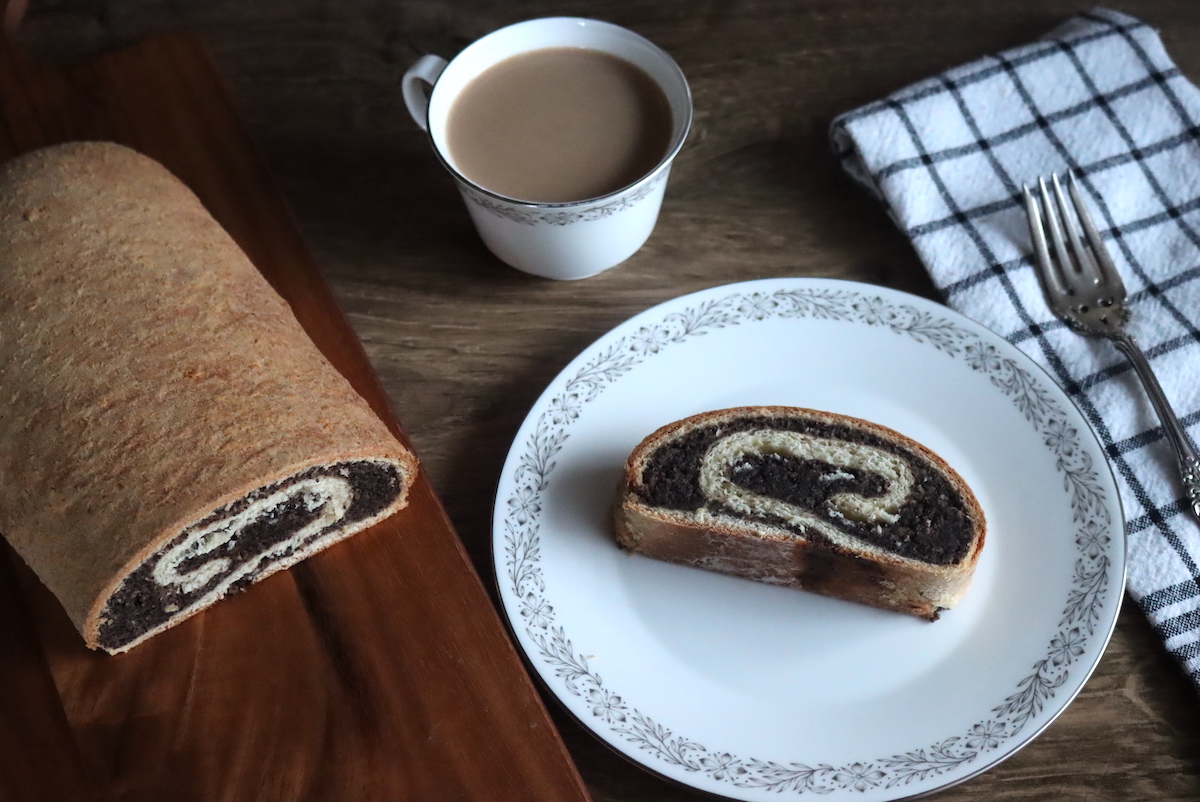
Dandelion Seed Bars
Pascal Baudar talks about making a “$600 power bar” from wild seeds and grains, and the cost is not in the purchased ingredients, but in his time instead. It’s a joke in his book, New Wildcrafted Cuisine.
Basically, the idea is that you can make a power bar (or equivalent) from wildcrafted ingredients, but you’d have to charge $600 each for your time in making it (paying yourself $25 to $30 an hour, the going rate in LA when he made it).
That includes time driving all over the city to find forage sources, gas, recipe development time, and more.
In reality, you can make a simple one from dandelion seeds from your yard in half an hour, so it’s hardly $600, but it’s still not as cheap as they are in the store.
Anytime you’re using time instead of money to get the job done, hopefully, you’re doing something you love more than sitting in a cubicle. I forage for recreation and unique flavors you can’t buy in the store, and I’m not doing it to pad my 401K.
You can use this simple recipe for homemade seed bars, replacing some of the seeds with dandelion seeds. While you can replace all the seeds, I’d suggest still mixing it up for tastiness. Try replacing the flax with dandelion and see how you like them.
If you want to go all in like Pascal did, you can forage other edible wild seeds to replace the other store-bought ingredients, too. And use homemade maple syrup, cider syrup, or wild honey as the sweetener. Or you can just stick with adding a handful of dandelion seeds and calling it good. It’s up to you.
Dandelion Seed Crackers
Another simple recipe: just make seedy crackers and replace the sesame, flax, or poppy seeds with dandelion seeds. This recipe is a simple wheat cracker topped with seeds, and it gets the job done.
Alternately, you can make true “seed crackers” in the dehydrator from just seeds, no wheat, and use dandelion seeds.
Dandelion Seed Mustard
A seedy mustard made with part mustard seed, and part dandelion seed gives you both flavors in a unique homemade spread.
Try replacing no more than half the seeds in this wild foraged mustard recipe with dandelion seeds, and make the rest with either storebought or wild mustard seeds.
Dandelion Seed Flour
You can make homemade flour from just about any seed, and we make dock seed flour from wild dock seed for baking, so why not dandelion seeds?
Grind them until fine, and you can replace a small amount of the flour in your recipe with dandelion seed flour.
Obviously, it’s a gluten-free seed flour, so it’s not going to make fluffy bread, but it will work for simple shortbread cookies or other recipes that don’t want much gluten anyway.
Try using dandelion seed flour instead of the birch bark flour in this wild-foraged shortbread cookie recipe.
Dandelion Seed Granola
As with crackers, you can put just about any seed you want in granola.
Try replacing the flax seeds in this granola recipe (or any other granola recipe) with dandelion seeds.
Dandelion Seed “Oatmeal”
A simple seedy porridge will work with dandelion seeds as well. We make a lovely acorn porridge with our wild harvested acorns, and the same recipe will work with dandelion seeds.
You can make it with all dandelions seeds, or replace just a small amount with dandelion seeds, it’s up to you.
Add a bit of water and slowly simmer for 5 to 10 minutes until you make a warm breakfast porridge.
Dandelion Seed Cheese
Pascal Baudar works with wild seeds a lot, making all manner of recipes…including seed cheeses.
Below, you’ll see an Instagram post where he talks about making seed cheese, and it can be made with any wild seed, including dandelion seeds.
Dandelion Seed Oil
Making homemade dandelion seed oil is a bit of a stretch, but it can be done. The seeds themselves are about 20% oil by weight, so not nearly as oily as many seed that are used for seed oils (flax, sesame, etc).
Still, wild oils can be made from most any oil containing seed. There are three main methods.
The first is with a home oil press; several are available online. Many require electrical power, but there is one called the Pitiba manual oil press that is hand crank, and I know some homesteaders use it to make homemade sunflower oil. (I also know one that uses it to make acorn oil from wild-harvested acorns).
No matter which one you choose, it’s an investment and not really worth it just for dandelion oil. You’d have to plan on making other seed oils, either homegrown or wild-harvested. In the wild, good sources include flax, mustard, hickory and acorn.
The second method is simmering the seeds in water, then turning off the heat and allowing the oil to float to the surface. This is how hickory oil was made traditionally. This blog post talks about that process with dandelion seeds.
Lastly, you can just use them as an oil source without extracting the oil. Will Bonsall talks about growing seed oil crops in his book Radical Self-Reliant Gardening, and he originally tried to extract the oils at home. It was a frustrating process, with low yields, so in the end, he just ended up toasting the seeds in a pan. They release the oil into the pan, and then he cooks on it.
It’s not deep frying or anything, but you can sautee easily that way. Small amounts come out of the seeds, just enough to give you a bit of oil to work with and keep things from sticking.
His goal is to avoid the grocery store altogether, and he’s been successful for many years, but he is giving up bulk oil in jugs in favor of this process.
Again, dandelion seed oil is the least practical use, and I only mention it for completeness.
Other Dandelion Seed Recipes
Honestly, once you have a jar of dandelion seeds, you can use them in place of many other common edible seeds like sesame, poppy, and flax seeds. They can make almost anything those cultivated seeds can make.
What would you make with dandelion seeds?
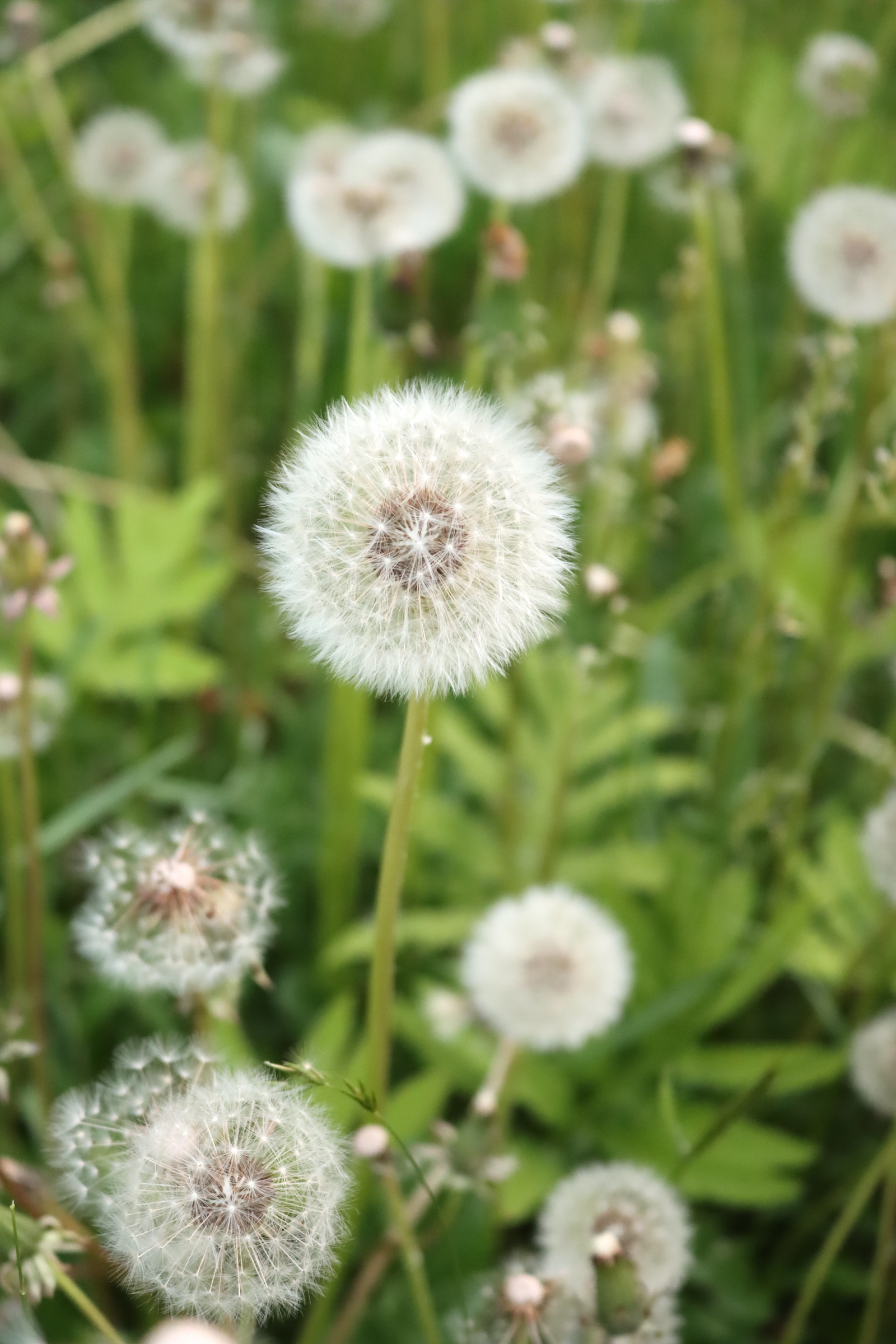
Identifying Dandelion Seeds
A final note I’ll add: Be sure that you have actual dandelions when collecting dandelion seeds from the wild. I know, you’re thinking, “Of course I know what a dandelion looks like!”
You’d be amazed at the number of people who casually misidentify anything with a yellow flower and a puffy seed head as a “dandelion.” A herbalist friend of mine only recently learned that coltsfoot (very early spring yellow flowers) and dandelion are, in fact, different plants. Even as a “plant person,” she’s been harvesting the wrong plant for years.
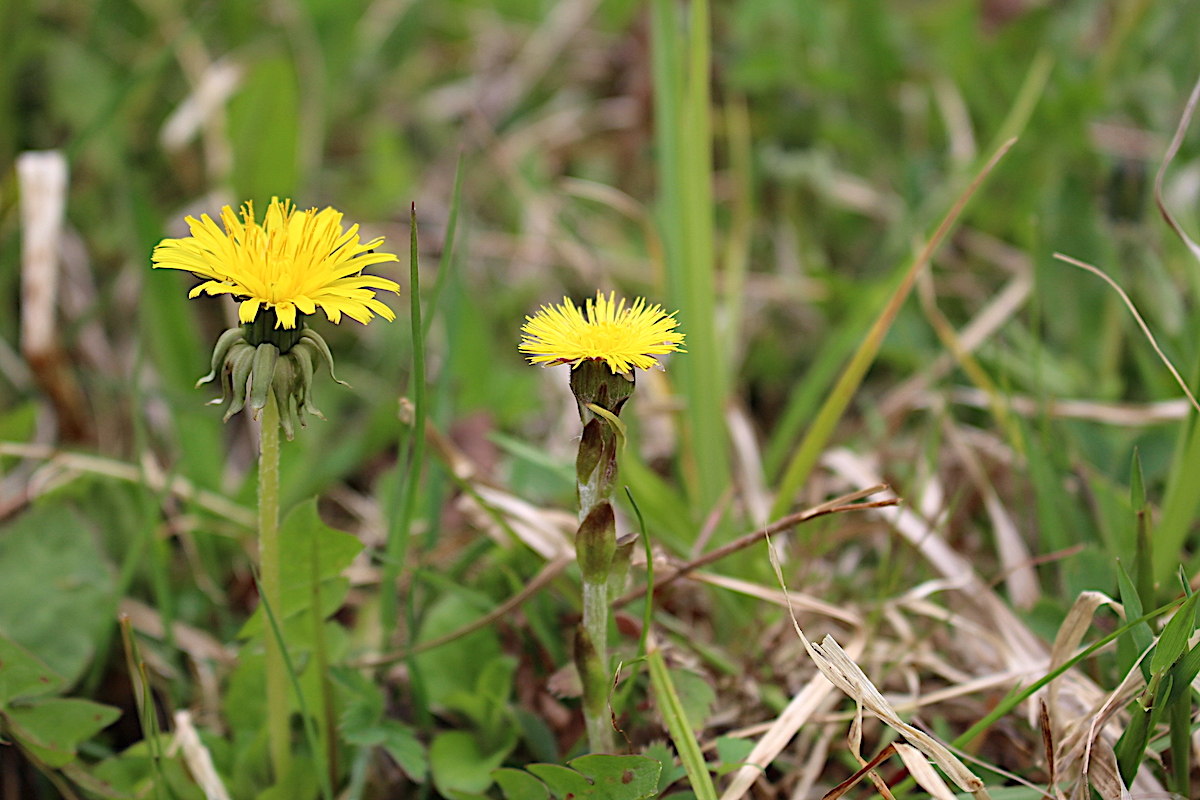
Those same two plants also produce fluffy seed heads, and though coltsfoot is usually earlier than dandelion, they do overlap.
The seed heads look different if you’re looking closely, though. Both are puffy, but not quite the same.
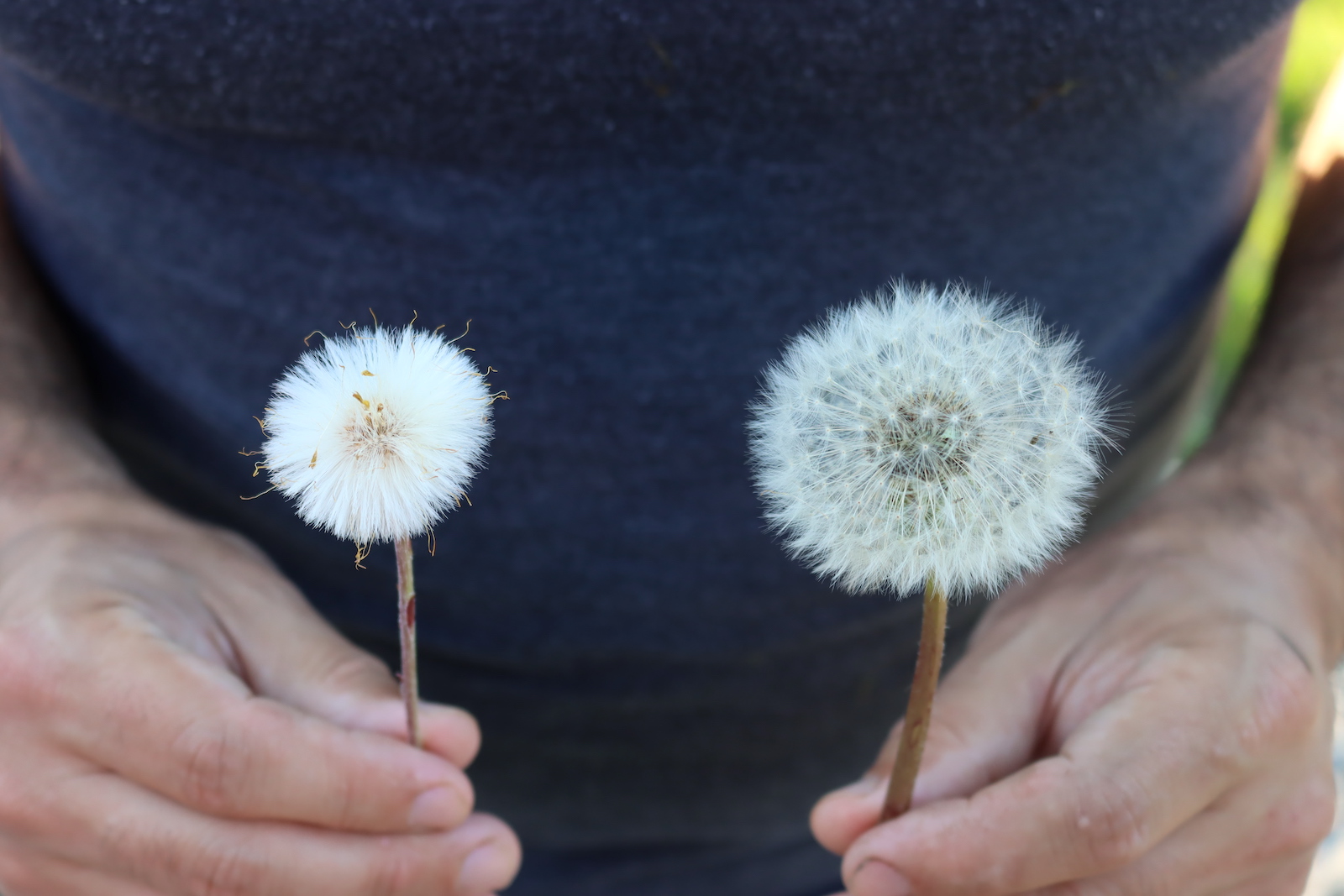
Beyond coltsfoot, you should also watch out for other dandelion look-alike plants, including:
- Cat’s Ear (Hypochaeris radicata)
- Autumn Hawkbit or Fall Dandelion (Scorzoneroides autumnalis)
- Sow Thistle (Sonchus spp.)
- Narrowleaf Hawksbeard (Crepis tectorum)
- Meadow Hawkweed (Hieracium caespitosum)
- Wild lettuce (Lactuca virosa)
- Rough Hawkbit (Leontodon hispidus)
- Prickly Lettuce (Lactuca serriola)
- Beach False Dandelions (Agoseris apargioides)
- Mountain Dandelion (Agoseris glauca)
- False Prairie Dandelions (Nothocalais troximoides)
Again, none are completely similar to dandelions, beyond puffy seed heads and yellow flowers, so it’s not like you need to be a botanist to tell them apart. Just pay attention as you harvest.
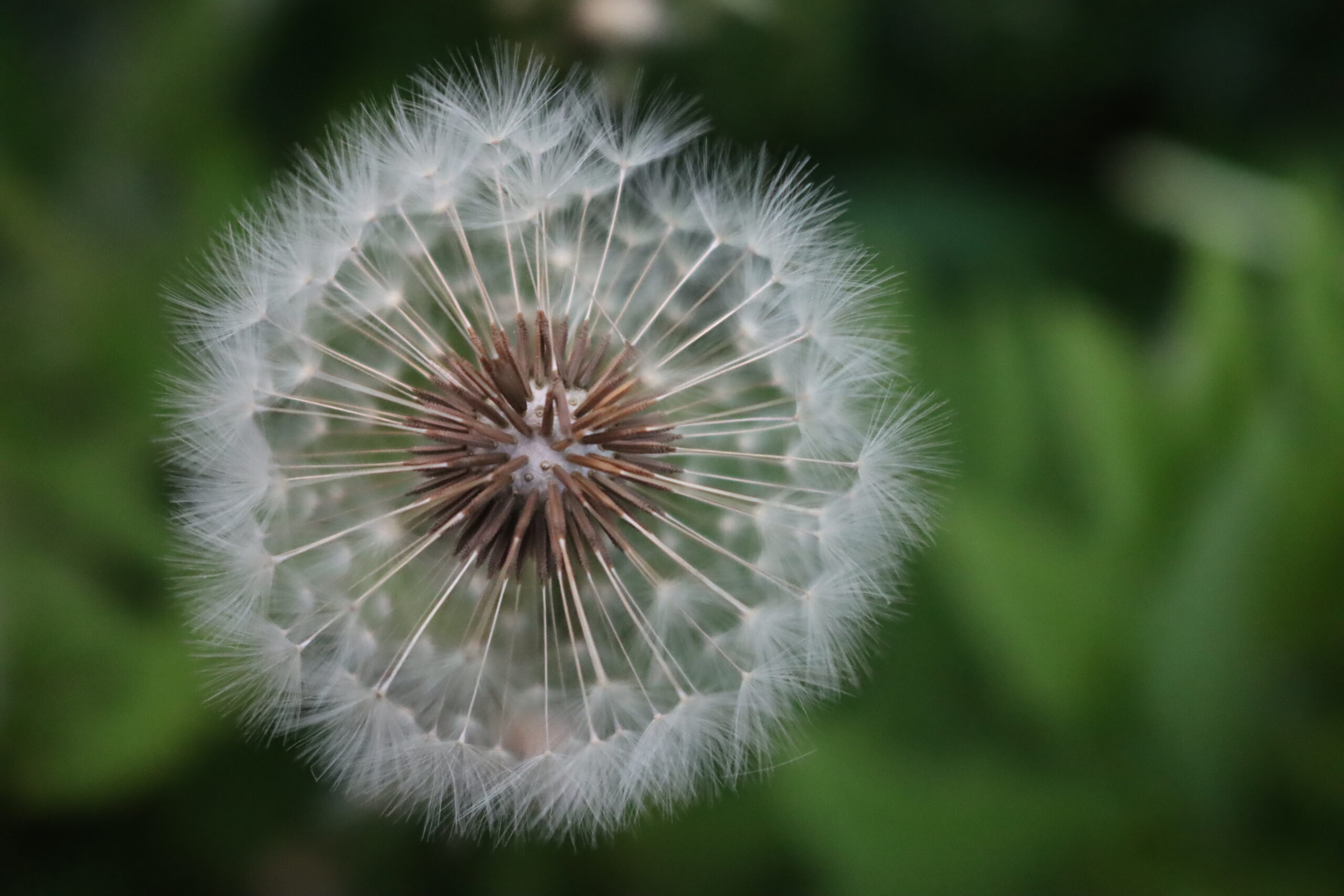
Dandelion Recipes
Looking for more dandelion recipes? There are just so many ways to eat a dandelion!
- Dandelion Wine
- Dandelion Liqueur
- How to Cook Dandelion Roots
- 20+ Dandelion Desserts (Cookies, Ice Cream, Pie, and More!)
- Dandelion Honey

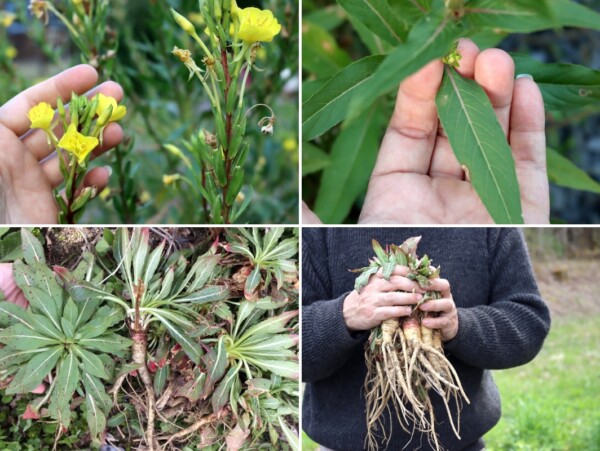
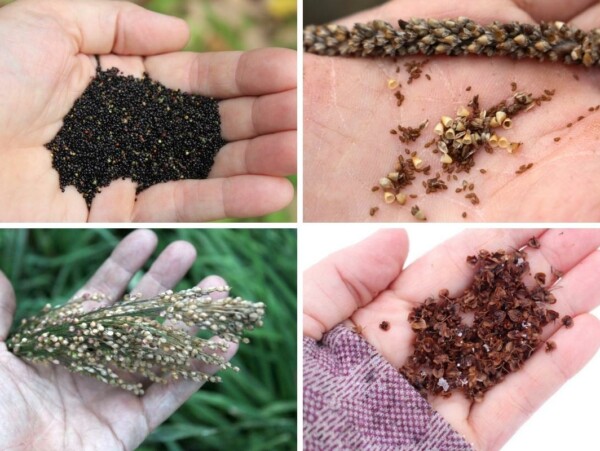
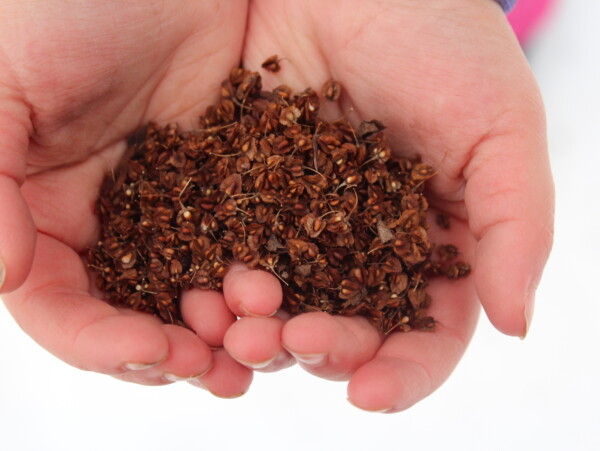
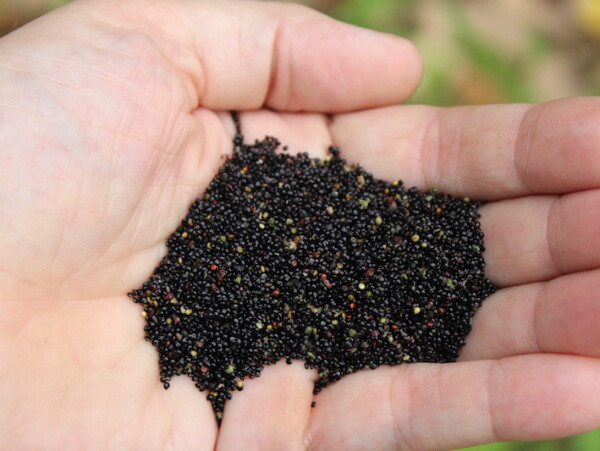
How do you store these for later use?
I assume dry well and package for storage in cool dark dry area?
Thanks, Matt
They’re actually quite dry as is, assuming you harvest them on a dry day. Once you get off the chaff, you can just store them. I have a big jar in my pantry from last year that I’m still working through, they keep just fine. (If you want to be extra sure though, you can lay them out on a sheet and allow them to dry for a day or two before packing them away).
What about simply using dandelion seed as a spice/seasoning like celery seed?
That’s an interesting thought. We might have to try that. Let us know if you try it and how you like it.